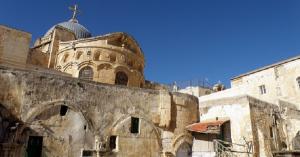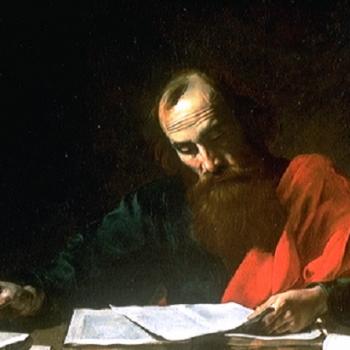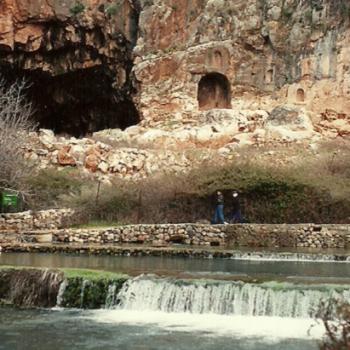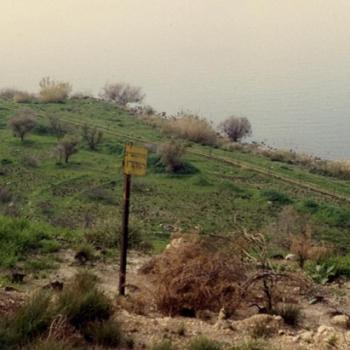We find the bedrock for what we believe inside the Church of the Holy Sepulcher in Jerusalem. It is the site of an event so huge that it turned the universe upside down: the resurrection of Jesus of Nazareth in the year 30 AD.
I’ve been there, years ago, but all I saw back then was the tourist level. But in the fall of 2016, archaeologists dug down below the tourist level. They first went thru a level of rubble. Underneath that level, they found a marble slab with a cross on it, laid by the Crusaders. Underneath that slab, they found bedrock, the place where Jesus’ body was laid: the place where the Lord of the universe rose from the dead. (See https://news.nationalgeographic.com/2016/10/jesus-tomb-opened-church-holy-sepulchre/.)

The empty tomb, followed by the appearances of the risen Jesus, becomes the bedrock for what we believe.
Now, how do we know that this is the place? When I first went to Israel, I believed that the so-called Garden Tomb next to Gordon’s Calvary was the site of the Empty Tomb. But then I realized that if the Holy Sepulcher church was not the right place, then the early church forgot where the Empty Tomb was, less than 100 years after it happened.
One hundred years after Easter, the emperor Hadrian built a pagan temple over a Jewish tomb that had become a holy site. What other Jewish tomb would qualify to become such a holy site? In the recent dig, stones from Hadrian’s pagan temple were found. Here in the early 300’s is where believers build the church to mark the spot where Jesus died for us and rose. They cut off the top of the tomb, to make it easy to see that the tomb was empty. The church was bulldozed during the Crusades and rebuilt. A lot has changed, but we cannot forget the place where it all happened.
Jesus’ resurrection is the bedrock for our faith. It is the rock that cannot be shaken, the fact that refuses to go away. Without Jesus’ resurrection, we have no basis on which to claim that our pet fairy tale is truer than anyone else’s pet fairy tale. What really happened on that day in that tomb almost 20 centuries ago makes a world of difference to us today.
Historians tend to be allergic to any claims about supernatural events. But how else is God going to invade history (if that ever happens)? And is it scientific or logical to rule an event out of bounds just because it’s never happened before? It’s better to ask, “What’s the evidence?”
Jesus scholars have developed criteria of authenticity to identify points of historical bedrock in the Gospels. There is some material in the Gospels that we have to take on faith. But whenever we have multiple independent witnesses, whenever we find details that are highly unlikely to have been invented, and whenever the event helps explain other facts that are beyond dispute, there’s where we can be even more confident that here we have the historical Jesus.
All of these criteria kick in to confirm Jesus’ resurrection. We have multiple independent witnesses, including Paul, the earliest (55 AD). We have details that the church would never have invented: the cowardice of the disciples, women as the earliest witnesses, and a Supreme Court justice (Joseph of Arimathea) from a town we’ve never heard of before, who asks for the body of Jesus and buries it in his own unused tomb, which guarantees that there will be no mistake about where he has been placed.
Plus, the resurrection becomes the best explanation for some hard-to-explain facts. How do we explain how men who were so scared they ran away from their Master, turned into men who would take a bullet for him? How do we explain how, the closer we get to the scene of the “crime,” skepticism shrinks and faith grows? That’s not how it works with myths, which arise far away, more than 100 years after the fact. How do we explain the survival of the church? Death of the leader put an end to all other Messianic movements back then. Michael Licona observes that the Church survived with none of the advantages of Buddha, Confucius, or Mohammed.
British scholar N. T. Wright says it’s highly unlikely that the resurrection accounts were invented. He points out that while the Gospels quote prophecy constantly in the crucifixion accounts, they don’t quote the Bible in their resurrection accounts, nor do they cite the resurrection as a reason for personal hope. He says the resurrection narratives read like accounts of an unexpected event that no one knows how to explain.
Wright believes there’s no other way we can explain the quick, radical reshaping of the Jewish hope of resurrection. Never before had anyone predicted that one person would rise from the dead long before everyone else. And for early Christians to say that Jesus was raised from the dead in a non-bodily sense, he says, would have been “historically impossible.”
We’ll look at some of the strongest objections to Jesus’ resurrection in my next post.















